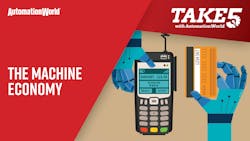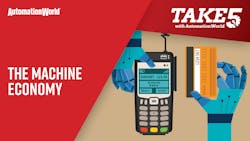Quick hits:
- The machine economy is defined as a network of smart, connected, self-sufficient machines that are economically independent and execute transactions with little to no human intervention.
- The IOTA Foundation developed an IoT public protocol using distributed ledger technology and a cryptocurrency wallet for IoT devices.
- Industrial Internet Consortium is working on an all-encompassing architecture that supports the machine economy.
- Siemens is using edge technology, digital twins, and automated guided vehicles to flexibly move products between machines based on a bill of process.
Related to this episode:
- Automation World Feature: The Machine-To-Machine Marketplace
- The Machine Economy is Upon Us
- Gain an in-depth look at PMMI's research on automation and hear from experts on industry topics by visiting PMMI's Business Intelligence video library.
This is the day that the Industry 4.0 movement has been waiting for—a day when machines are autonomous and they self-optimize. A day when machines work around failures on the floor, a day when machines know that supplies are low and that they should call for more. By the way, the machine will [ay for new products using its own wallet.
It’s called the machine economy: defined as a network of smart, connected, self sufficient machines that are “economically independent” and execute transactions with little to no human intervention. The building blocks to this factory of the future is a trifecta of technology that includes the Internet of Things, artificial intelligence, and blockchain.
Now this concept was first brought to my attention about a year and a half ago when I spoke to executives at an organization called the IOTA Foundation. It was formed in 2017 as an international consortium of European universities and technology companies. They created a protocol layer for IoT that defines how devices transact with each other. Today, IOTA focuses more on building the secure infrastructure using distributed ledger technology. They call that technology Tangle, and its purpose is to enable secure micropayments between machines. Recently, IOTA launched Firefly, a cryptocurrency wallet supported by most IoT devices.
Of course, there’s way more work to do if machines are going to act autonomously on the factory floor. We’ll also need to incorporate digital twin technology, mobile robots, standardized machine communication, a distributed ecosystem, and—of course—security. In the June issue of Automation World we explore some of the efforts underway to create the machine economy landscape.
So before manufacturers can consider working in a machine economy there needs to be a common architecture to support it. IOTA foundation is working on the public protocol and securing transactions.
Meanwhile, the Industrial Internet Consortium is also working on architecture.They’ve come up with a connectivity framework for syntactic interoperability. They also have a reference architecture for application development and a business strategy framework to identify enterprise issues, as well as the opportunities of the new IoT apps. IIC is also working on a cross-industry security framework. They are testing these frameworks In a few pilot projects.
In Ireland, for example, they’ve created a software-defined infrastructure using big data that runs on a physical network. The result: a project called Bluelight which allows emergency vehicles to securely connect to a hospital system and relay information while in route. At the same time, it’s also gathering data about traffic levels to find the fastest way to the hospital.
So how would this work on the factory floor—especially when there’s a lot of older machines? Well, we just need to take a look at what Siemens is doing in its own plants. It’s using a combination of edge technology to create an intelligent wrapper around existing machines. It has digital twin technology to send instructions based on a bill of process. And key to flexibility and workarounds here are autonomous guided vehicles that move products between machines.
This is just an early example of our journey toward cyber-physical machines and the machine economy, which is still a good decade away. And it’s not the machines or the technology that is stalling adoption, experts say. Rather, its people and culture that are the biggest obstacles. I’m confident, however, that machines will be reaching into their own cryptocurrency wallets in the not-so-distant future. So stay tuned! Thank you for joining me today for Take Five with Automation World.
Leaders relevant to this content:





